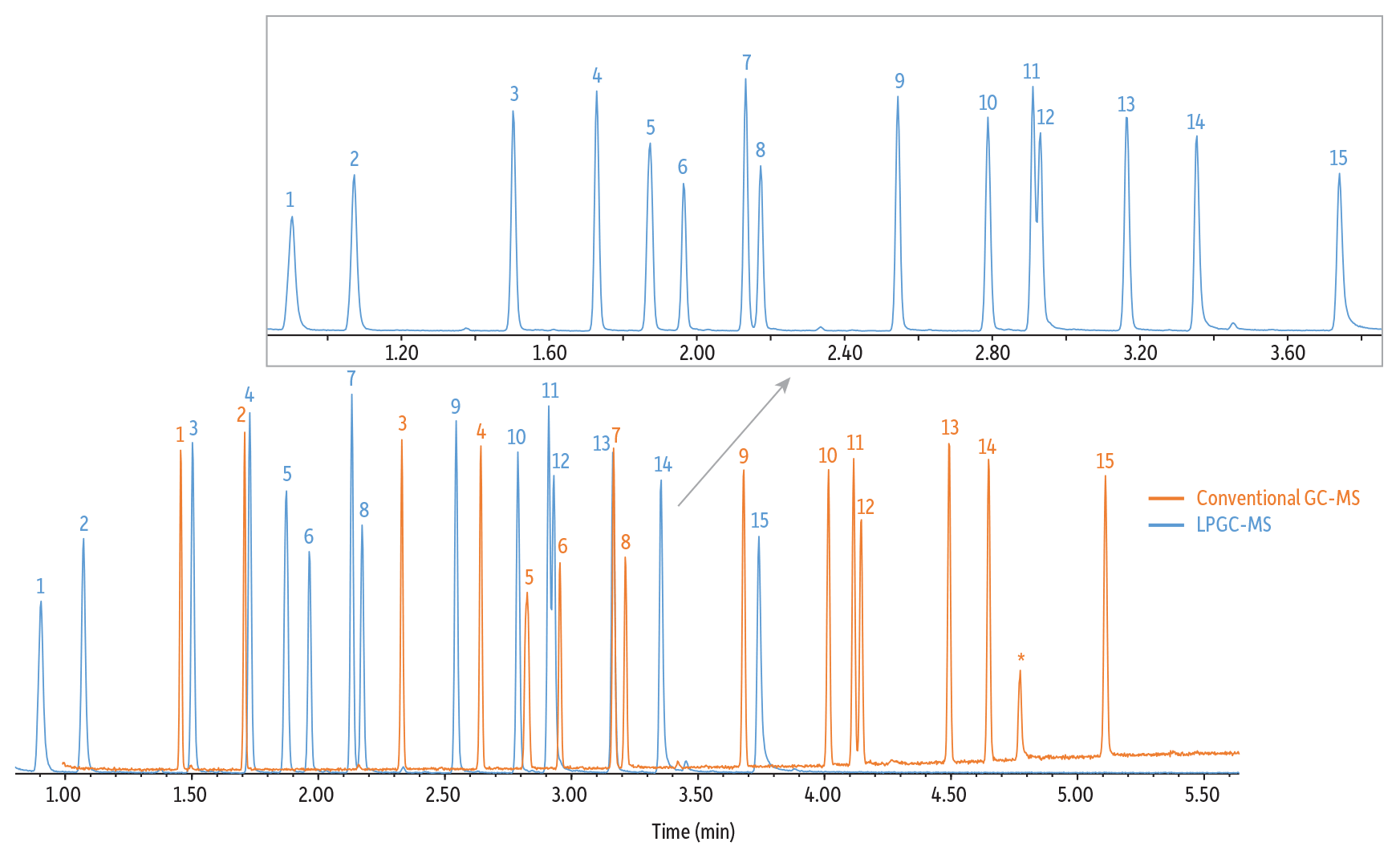Faster LPGC-MS Phthalates Analysis Uses 67% Less Helium
Featured Application: Phthalates on LPGC Rxi-35Sil MS
- Analyze phthalates 1.4x faster than conventional GC-MS.
- Cut costs by reducing helium consumption 67%.
- Pre-connected LPGC column kit prevents leaks, simplifies installation, and allows large-volume injection.
Phthalates are industrial additives that are commonly used to make plastics more flexible, and they are easily released through various degradation processes. They have become ubiquitous and are found in air, water, food, consumer products, and even the human body. Efficient methods are needed for analyzing phthalates both as raw materials and as contaminants. Phthalates analysis is typically done by conventional GC-MS using a capillary column that is 30 m or longer. However, this approach requires a high flow rate and uses a lot of helium, which is a limited and costly resource.
Low-pressure GC-MS (LPGC-MS) is an attractive alternative because it can significantly reduce helium consumption and also speed up the analysis, improving lab productivity. As shown in Figure 1, the LPGC-MS method is 1.4x faster and uses 67% less helium than the conventional phthalates analysis. A Restek LPGC Rxi-35Sil MS column kit provides additional benefits because it is factory connected to ensure easy installation and a leak-free connection between the analytical and restrictor columns. It also has the capacity for large-volume injection, whereas narrow-bore columns can be overloaded quickly. Visit www.restek.com/lpgc to learn more about this powerful technique.
Figure 1: Phthalates on LPGC Rxi-35Sil MS Compared to Conventional GC-MS Analysis

| Peaks | tR (30 m) | tR (LPGC) | Conc. (ppm) | |
|---|---|---|---|---|
| 1. | Dimethyl phthalate | 1.456 | 0.904 | 10 |
| 2. | Diethyl phthalate | 1.709 | 1.073 | 10 |
| 3. | Diisobutyl phthalate | 2.33 | 1.504 | 10 |
| 4. | Di-n-butyl phthalate | 2.642 | 1.73 | 10 |
| 5. | Bis(2-methoxyethyl) phthalate | 2.824 | 1.873 | 10 |
| 6. | Bis[4-methyl-2-pentyl] phthalate isomers | 2.955 | 1.964 | 10 |
| 7. | Di-n-pentyl phthalate | 3.167 | 2.133 | 10 |
| Peaks | tR (30 m) | tR (LPGC) | Conc. (ppm) | |
|---|---|---|---|---|
| 8. | Bis(2-ethoxyethyl) phthalate | 3.212 | 2.173 | 10 |
| 9. | Di-n-hexyl phthalate | 3.68 | 2.545 | 10 |
| 10. | Butyl benzyl phthalate | 4.015 | 2.789 | 10 |
| 11. | Bis(2-ethylhexyl) phthalate | 4.115 | 2.911 | 10 |
| 12. | Bis(2-butoxyethyl) phthalate | 4.146 | 2.931 | 10 |
| 13. | Dicyclohexyl phthalate | 4.492 | 3.166 | 10 |
| 14. | Di-n-octyl phthalate | 4.649 | 3.357 | 10 |
| 15. | Dinonyl phthalate | 5.11 | 3.741 | 10 |
| Column | See notes |
|---|---|
| Standard/Sample | EPA method 8061A phthalate esters mixture (cat.# 33227) |
| Diluent: | Hexane |
| Conc.: | 100 µg/mL |
| Injection | |
| Inj. Vol.: | 1 µL split (split ratio 10:1) |
| Liner: | Topaz, splitless, single taper inlet liner, 4.0 mm x 6.5 x 78.5 (cat.# 23303) |
| Inj. Temp.: | 280 °C |
| Carrier Gas | He |
| Detector | MS |
|---|---|
| Mode: | Scan |
| Transfer Line Temp.: | 280 °C |
| Analyzer Type: | Quadrupole |
| Source Temp.: | 330 °C |
| Quad Temp.: | 180 °C |
| Electron Energy: | 70 eV |
| Tune Type: | PFTBA |
| Ionization Mode: | EI |
| Instrument | Agilent 7890B GC & 5977A MSD |
| Sample Preparation | The standard was diluted with hexane to 100 ppm; analyzed in a 2 mL, short-cap, screw-thread vial (cat.# 21143); and capped with a short-cap, screw-vial closure (cat.# 24495). |
| Notes | Conventional (30 m) Analysis: Column: Rxi-35Sil MS, 30 m, 0.25 mm ID, 0.25 µm (cat.# 13823) Temp. program: 200 °C (hold 0.5 min) to 330 °C at 30 °C/min (hold 5 min) Flow: 2 mL/min Scan start time: 0.9 min Scan range: 55-400 amu Scan rate: 10 scans/sec LPGC-MS Analysis: Column: LPGC Rxi-35Sil MS column kit, includes 10 m x 0.32 mm ID x 0.25 μm Rxi-35Sil MS analytical column and 5 m x 0.15 mm ID Rxi restrictor factory connected via SilTite connector (cat.# 11806) Temp. program: 180 °C (hold 0.5 min) to 200 °C at 75 °C/min to 300 °C at 35 °C/min (hold 5 min) Flow: 0.9 mL/min Scan start time: 0.5 min Scan range: 55-300 amu Scan rate: 9.7 scans/sec For phthalates analysis, we also recommend Resprep C18 SPE disks (cat.# 24004) and C18 SPE cartridges (cat.# 28961) for sample preparation. |

